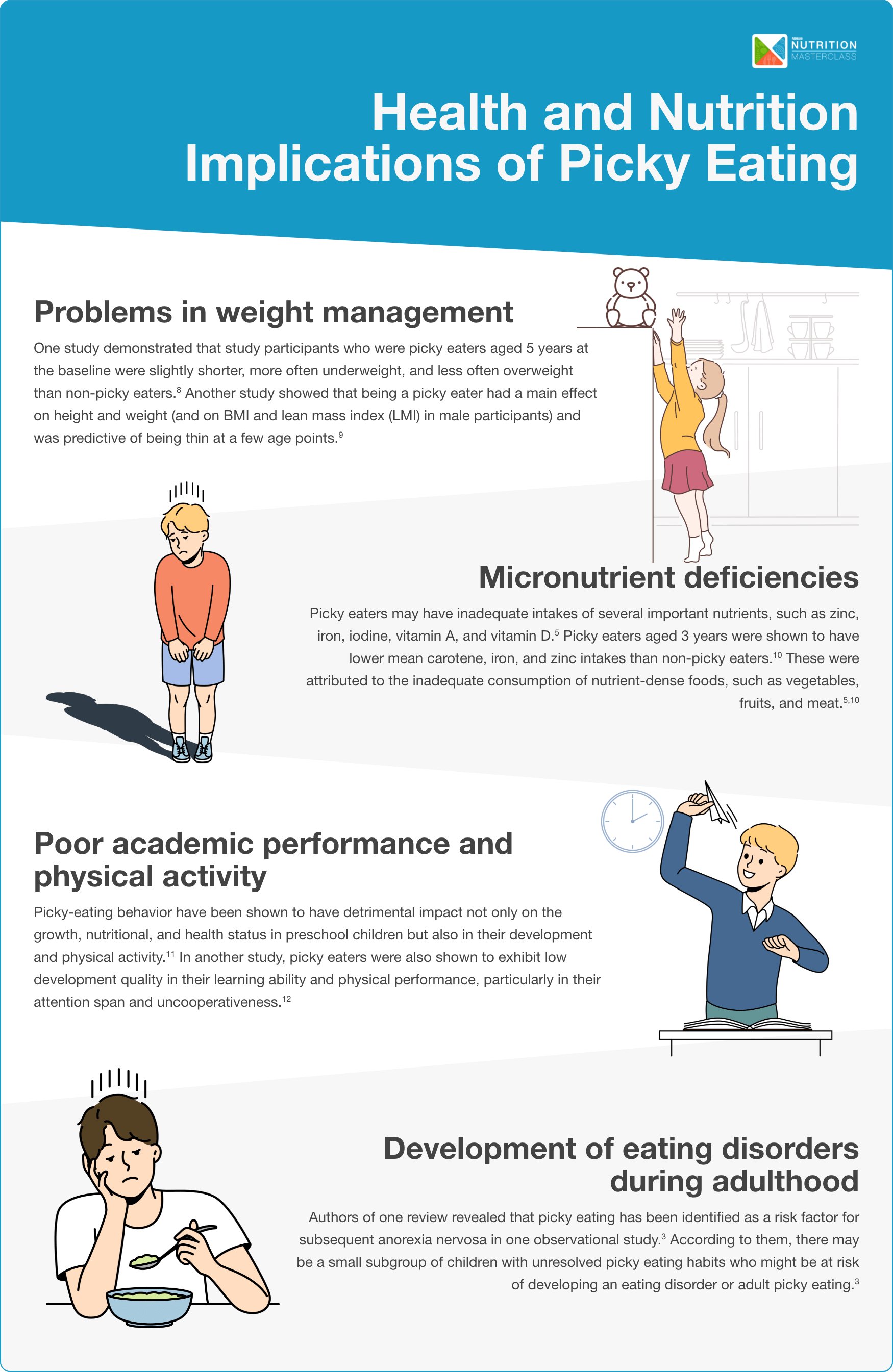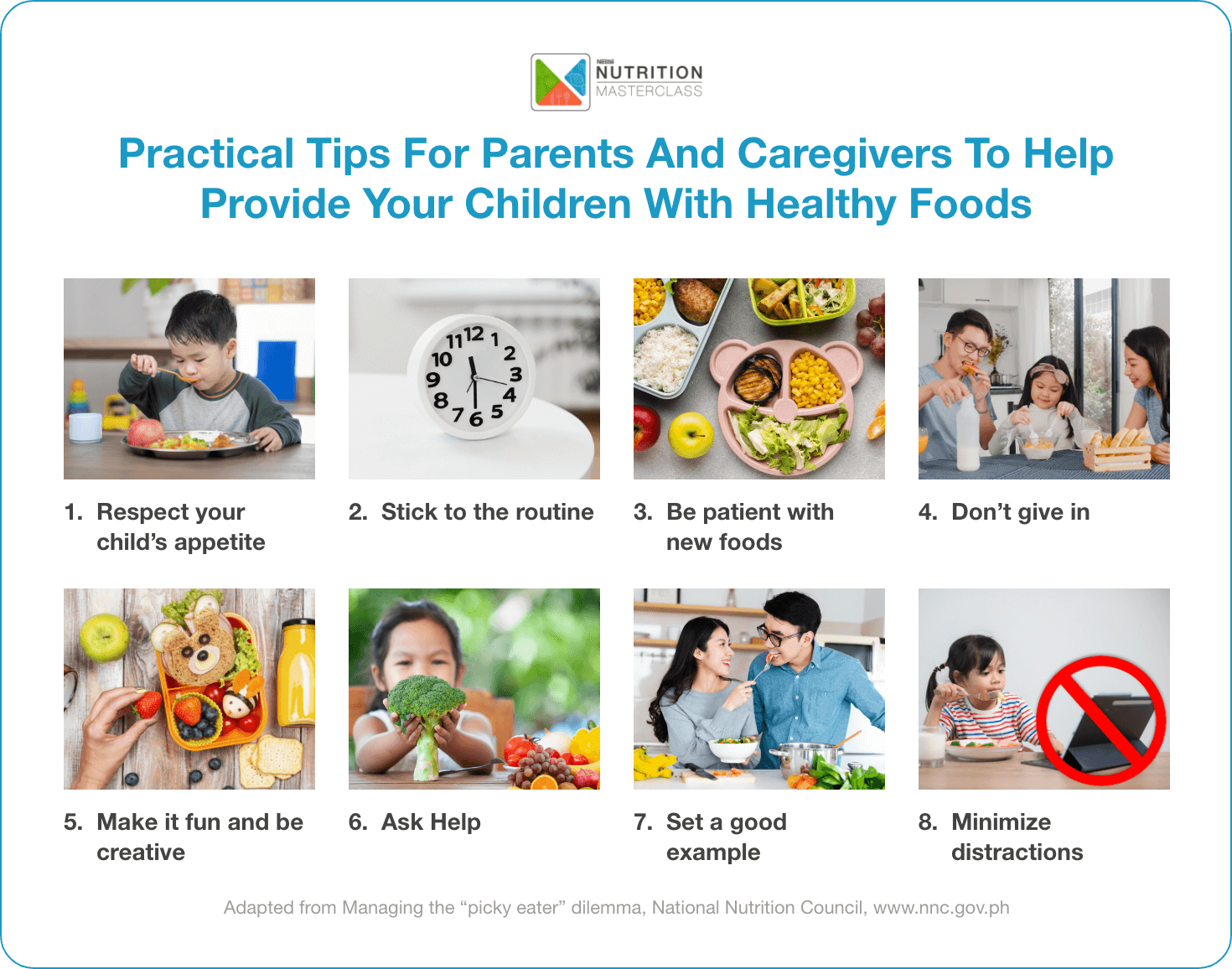Introduction

Picky (or fussy) eating is one of the common feeding concerns of children and a cause of worry for many parents. Though there is no established standard definition, picky eating behavior is characterized by the unwillingness to eat familiar or try new foods, as well as having strong preferences towards certain foods.1 The most commonly accepted definition of picky eating is consumption of an inadequate variety or quantity of foods through the rejection of a substantial amount of both familiar and unfamiliar foods.2,3 Other possible definitions include restrictions on vegetable intake, provision of meals that are different from those of the caregivers/family, special methods of food preparation, consumption of inadequate amounts of food, and disruption of daily routines that is problematic to the child, parent or parent-child relationship.3
Picky eating behavior is commonly reported among toddlers and may extend until school-age years. Some studies in neighboring countries reported prevalence of picky eaters ranging from 25% to 66%.4 In the Philippines, it was reported that 53% of Filipino mothers consider their children picky eaters.5
In assessing children for picky-eating behaviors, pediatricians look for signs like neophobia (extreme dislike or fear of anything new or unfamiliar), strong preference or rejection of particular food items, and inadequate intake or variety of food present during toddler years. Various assessment tools for determining intrinsic features of picky eating were also compared,6 with the Children’s Eating Behaviour Questionnaire (CEBQ): food fussiness subscale as the most commonly used tool; however, this goes beyond picky eating as it also assesses the feeding style of the child. Moreover, it is important that various tools be used, looking at intrinsic and extrinsic factors for a more holistic approach.
Factors Related to Picky Eating Behavior
Several factors influence picky eating behaviors in children.7 These include:
- childhood factors such as age, personality, tactile defensiveness, emotionality, and cognitive factors
- genetics
- environmental factors such as culture, peer influence, and media
- parent influence particularly parent feeding practices
Causes of Picky Eating Behavior
Possible specific causes for fussy eating include early feeding difficulties, late introduction of lumpy foods at weaning, pressure to eat, and early choosiness, especially if the mother is worried about this.3
Identifying the factors or reasons behind picky eating behaviors is vital for parents and child caregivers so that appropriate interventions or strategies can be made early to correct the behaviors.
Health and Nutrition Implications of Picky Eating

Generally, studies and pediatricians note that though picky eating is common and a cause of considerable parental concerns and stress, it does not equate to malnutrition, and the majority of the children grow normally. Constant monitoring of the primary health provider is still important as possible deficiencies to essential nutrients are possible if picky eating is not managed correctly.
- Problems in weight management - One study demonstrated that study participants who were picky eaters aged 5 years at the baseline were slightly shorter, more often underweight, and less often overweight than non-picky eaters.8 Another study showed that being a picky eater had a main effect on height and weight (and on BMI and lean mass index (LMI) in male participants) and was predictive of being thin at a few age points.9
- Micronutrient deficiencies - Picky eaters may have inadequate intakes of several important nutrients, such as zinc, iron, iodine, vitamin A, and vitamin D.5 Picky eaters aged 3 years were shown to have lower mean carotene, iron, and zinc intakes than non-picky eaters.10 These were attributed to the inadequate consumption of nutrient-dense foods, such as vegetables, fruits, and meat.5,10
- Poor academic performance and physical activity - Picky-eating behavior have been shown to have detrimental impact not only on the growth, nutritional, and health status in preschool children but also in their development and physical activity.11 In another study, picky eaters were also shown to exhibit low development quality in their learning ability and physical performance, particularly in their attention span and uncooperativeness.12
- Development of eating disorders during adulthood - Authors of one review revealed that picky eating has been identified as a risk factor for subsequent anorexia nervosa in one observational study.3 According to them, there may be a small subgroup of children with unresolved picky eating habits who might be at risk of developing an eating disorder or adult picky eating.
Strategies to avoid picky eating among children
There are several strategies and interventions to avoid or ameliorate picky eating in children. One of these is exclusive breastfeeding. A study concluded that the duration of exclusive breastfeeding influences pickiness and contributes to the increased vegetable intake in later childhood.13 Breastfed babies are exposed to an assortment of flavors from maternal milk, and so the transition from maternal milk to complementary foods may be easier for these children.13 This highlights the importance of proper and correct nutrition during the first 1000 days of the child, which starts from conception up to 2 years of age.
Some practical tips for parents and caregivers are suggested by the National Nutrition Council to help provide your children with healthy and nutritious foods, and restore harmony during mealtime14:

- Respect your child’s appetite. Avoid forcing a meal or snack on your child if he or she isn’t hungry. Refrain from bribing or forcing your child to eat certain foods or to clean his or her plate. Force feeding or pressuring your kid to eat may only lead to a power struggle. This could also make your child associate mealtime with anxiety and frustration or become insensitive to his or her own hunger and satiety cues.
- Stick to the routine. Offer food at around the same time each day. If your child doesn’t eat a meal, take the opportunity to offer healthy foods during the regular snack time.
- Be patient with new foods. When offered a new food, children usually touch or smell the food. Children may even put small bits of food in their mouths and then spit them out. Repeated exposure to a new or unfamiliar food may be needed before your child takes the first bite. It takes 10-20 exposures for children to learn to enjoy certain foods. Create a positive atmosphere for trying new foods during mealtimes.
- Don’t give in. Never exempt a child and prepare a separate meal if your child refuses to eat your family meal. Providing a separate meal specially prepared for your child may promote picky eating. Encourage your child to sit and remain at the table for the allotted mealtime even if he or she doesn't eat.
- Make it fun and be creative. Make meals look incredible and appetizing by cutting foods into various shapes. Dish up some breakfast foods for dinner. Include a variety of brightly colored foods in the food repertoire.
- Ask Help. Involve your child in selecting fruits, vegetables and other healthy foods when in the grocery. Avoid buying anything that you don't want your child to eat. At home, get your child involved in food preparation or setting the table.
- Set a good example. Model healthy eating habits to your child. If you eat a variety of healthy foods yourself everyday, your child will more likely follow your lead.
- Minimize distractions. Turn the TV and other electronic gadgets off during mealtimes. This way, your child could focus on eating. Bear in mind that TV or social media advertising may also influence your child to crave for sugary or non-nutritious foods.
Creative menu planning need not be expensive or require professional culinary skills. You may experiment with local and indigenous ingredients readily available in your area or even in your backyard. Incorporating these ingredients into familiar food items or favorite viands can help expose picky eaters to a variety of food groups.
For example, amp up the nutritional value of the usual spaghetti by adding tofu, green veggies like moringa (malunggay) and deep-colored veggies like carrots in meatballs. The usual commercial chips may be replaced by water spinach (kangkong) chips or veggie tempura with real cheese sauce. Kids with a sweet tooth will love the addition of squash (kalabasa), sweet potatoes (camote) or other tubers in pastillas or leche flan. Make healthier snack items like cheese sticks, rice cake (puto), cookies or veggie balls by incorporating local greens like amaranth (kulitis), Malabar spinach (alugbati) and local spinach.
Here’s a sample one-week menu for your picky eaters. Vegetables and fruits are incorporated in the usual viands and snacks. Portions will depend on the recommended amount per age.
| ONE-WEEK SAMPLE MENU FOR PICKY EATERS | |||||
|---|---|---|---|---|---|
| DAY | BFAST | AM SNACK | LUNCH (SCHOOL BAON) | PM SNACK | DINNER |
| Monday | Cheesy Veggie omelet Pandesal Fresh Orange juice | Peanut Butter Camote Balls | Tofu, Pork and Malunggay Lumpiang Shanghai Brown Rice Apple | Carrot Spaghetti with Veggie meatballs (Add grated carrots in the sauce and meatballs) | Sinigang with vegetables (see link below table) Brown Rice Creamy Avocado and Banana dessert |
| Tuesday | Oatmeal with Banana or Apple Milk | Malunggay Cheese Sticks | Arroz ala Cubana Brown Rice Kiat Kiat | Brown Rice Champorado with Crispy Dilis | Chicken Pork Adobo with Liver (see link below table) Vegetable Tempura Brown Rice Carrot Pastillas |
| Wednesday | Sardines Misua with Patola Brown Rice Fresh Ponkan Juice | Kalabasa Maja Blanca | Cheesy Tortang Talong Brown Rice Banana | Ginataang Monggo (Lelut Balatong) | Pork Pochero (see link below table) Brown Rice Buko Juice or Buko Shake |
| Thursday | Breakfast Cereal with nuts and fruits (see link below table) Milk (see link below table) | Malunggay Cookies | Veggie and Tuna Pancake Okonomiyaki Brown Rice Grapes | Cheese Pimiento Star Sandwich (or any fun shapes) | Sipo Eggs with vegetables Brown Rice Mango Sago |
| Friday | Veggie Tinapa Fried Rice with Egg | Veggie Balls and Kangkong chips with sweet and sour dip or garlic aioli | Tortang giniling with Alugbati Brown Rice Banana | Mango Champorado | Chicken Binakol with papaya & Malunggay (see link below table) Brown Rice Milky Melon Juice |
| Saturday | Brown Rice Arrozcaldo with Kulitis Papaya with milk | Ginanggang | Pininyahang Manok with carrots and potato Brown Rice Ube haleya | Tofu, beef and veggie burger with bacon and cheese | Fried Fish Escabeche Malunggay Fritters Brown Rice Fruit Salad (see link below table) |
| Sunday | Banana Pancake (upgraded and less sinful maruya) (see link below table) Taho or flavored soymilk | Kalabasa Brownies | Fried Chicken Cheesy Broccoli soup Brown rice Chocolate covered fruit | Creamy Malunggay Pesto Pasta with bacon bits | Beef Bulalo with veggies and sweet corn Brown Rice Knickerbocker (Fresh fruit halo halo with dragon fruit) |
Sinigang with vegetables - https://www.maggi.ph/recipes/sinigang-na-bangus-sa-sampaloc/
Chicken Pork Adobo with Liver - https://www.maggi.ph/recipes/supreme-chicken-pork-adobo/
Pork Pochero - https://www.maggi.ph/recipes/pork-pochero/
Breakfast Cereal - https://www.nestle-cereals.com/ph/products-promotions/brands/koko-krunch-brand
Chicken Binakol - https://www.maggi.ph/recipes/easy-chicken-binacol/
Fruit Salad - https://www.createwithnestle.ph/recipes/classic-fruit-salad
Banana Pancake - https://www.milo.com.ph/recipes/milo-oat-n-banana-pancakes
Lastly, create positive social experiences around mealtimes. Let your child enjoy each mealtime experience with the family.
Message to RNDs
Picky eating of children is a phase that can be powered through with a supportive environment and the guidance of health professionals. Since the first 1000 days of a child’s life (conception until two years of age) is the golden window of opportunity, this is the perfect time to invest early in their health. As RNDs, educate parents and/or child caregivers important child feeding techniques including responsive feeding, routine establishment, and creativity in food presentations.
Pro Tip
Despite the challenges of picky eating, proper nutrition can be achieved through MOVABA - MOderation, VAriety and BAlance. Include a VAriety of food in the child’s diet with a BAlance of nutrients and keep indulgent favorite food items in MOderation.


 Ailyn Mae Kuan Del Rio , RND, MSc
Ailyn Mae Kuan Del Rio , RND, MSc















No comments here yet.